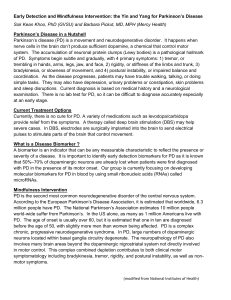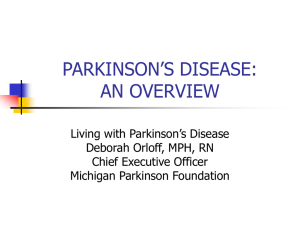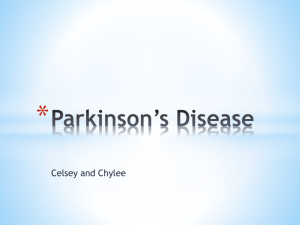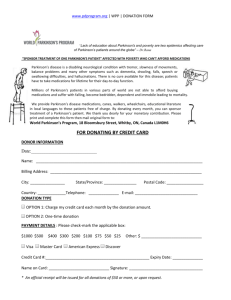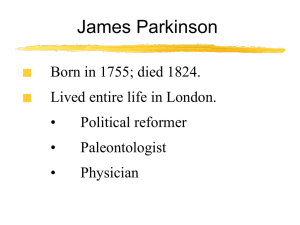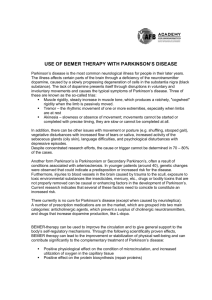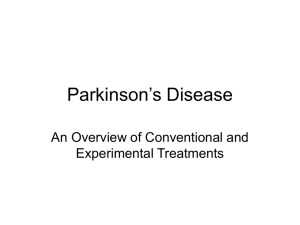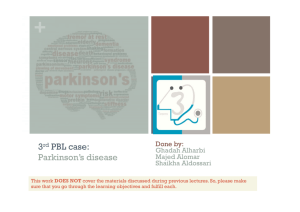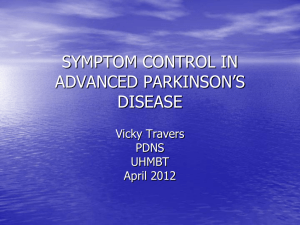What is Parkinson"s Article?
advertisement
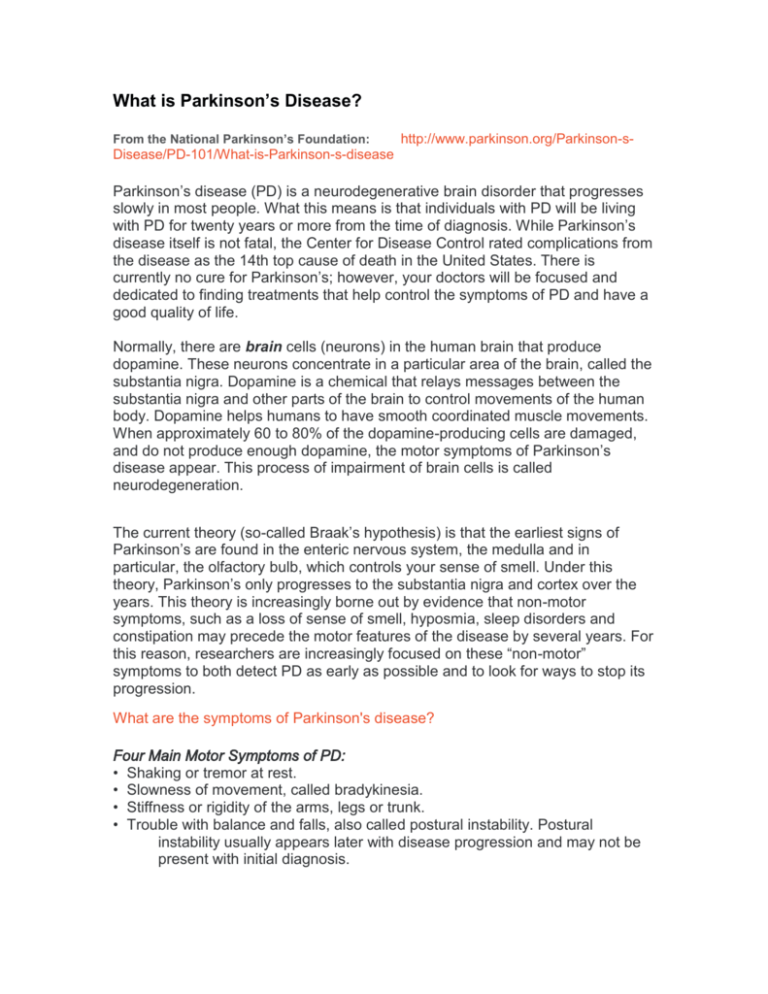
What is Parkinson’s Disease? From the National Parkinson’s Foundation: http://www.parkinson.org/Parkinson-s- Disease/PD-101/What-is-Parkinson-s-disease Parkinson’s disease (PD) is a neurodegenerative brain disorder that progresses slowly in most people. What this means is that individuals with PD will be living with PD for twenty years or more from the time of diagnosis. While Parkinson’s disease itself is not fatal, the Center for Disease Control rated complications from the disease as the 14th top cause of death in the United States. There is currently no cure for Parkinson’s; however, your doctors will be focused and dedicated to finding treatments that help control the symptoms of PD and have a good quality of life. Normally, there are brain cells (neurons) in the human brain that produce dopamine. These neurons concentrate in a particular area of the brain, called the substantia nigra. Dopamine is a chemical that relays messages between the substantia nigra and other parts of the brain to control movements of the human body. Dopamine helps humans to have smooth coordinated muscle movements. When approximately 60 to 80% of the dopamine-producing cells are damaged, and do not produce enough dopamine, the motor symptoms of Parkinson’s disease appear. This process of impairment of brain cells is called neurodegeneration. The current theory (so-called Braak’s hypothesis) is that the earliest signs of Parkinson’s are found in the enteric nervous system, the medulla and in particular, the olfactory bulb, which controls your sense of smell. Under this theory, Parkinson’s only progresses to the substantia nigra and cortex over the years. This theory is increasingly borne out by evidence that non-motor symptoms, such as a loss of sense of smell, hyposmia, sleep disorders and constipation may precede the motor features of the disease by several years. For this reason, researchers are increasingly focused on these “non-motor” symptoms to both detect PD as early as possible and to look for ways to stop its progression. What are the symptoms of Parkinson's disease? Four Main Motor Symptoms of PD: • Shaking or tremor at rest. • Slowness of movement, called bradykinesia. • Stiffness or rigidity of the arms, legs or trunk. • Trouble with balance and falls, also called postural instability. Postural instability usually appears later with disease progression and may not be present with initial diagnosis. Secondary Symptoms of PD May Include: • • • • • • • • Small, cramped handwriting, called micrographia. Reduced arm swing on the affected side. Slight foot drag on affected side creating a shuffled walk. ”Freezing” a term used to describe the phenomenon of being “stuck in place” when attempting to walk. Loss of facial expression due to rigidity of facial muscles, called hypomimia. Low voice volume or muffled speech, called hypophonia. Tendency to fall backwards, called retropulsion. Decrease ability in automatic reflexes such as blinking and swallowing. • • • • • • • Depression Anxiety - beyond the normal response to stress Hallucinations, psychosis Sleep disturbances (vivid dreams, talking and moving during night sleep) Constipation Pain Increase in dandruff (seaborrhea dermatitis) or oily skin Other Symptoms of PD MOTOR SYMPTOMS Bradykinesia (slowness of movement) Rigidity (stiffness of movement) Tremor (involuntary shaking of the hands, feet, arms, legs, jaw, or tongue, usually more prominent at rest) Postural Instability (tendency to fall without explanation, usually when pivoting) NON-MOTOR SYMPTOMS Mood (depression, anxiety, irritability) Cognitive changes (attention, visuo-spatial problems, memory problems, personality changes, psychosis/hallucinations) Orthostatic hypotension (lightheaded and low blood pressure upon standing) Constipation and early satiety (a feeling of fullness after eating small amounts) Hyperhidrosis (excessive sweating), especially of hands and feet Seborrhea dermatitis (dry skin) dandruff Urinary urgency, frequency and incontinence Loss of sense of smell (Anosmia) Sleep disorders Insomnia, Excessive Daytime Sleepiness (EDS), Rapid Eye Movement Behavioral Disorder (RBD) or active dreaming, dream enactment, involuntary movements and vocalizations during sleep, Restless Legs Syndrome (RLS)/Periodic Leg Movements Disorder (PLMD) Sensory (pain, tightness, tingling, burning) MIXED MOTOR AND NON-MOTOR SYMPTOMS Drooling due to slowed swallowing (Sialorrhea) Speech and swallowing problem
